
by Carrie Stevenson | Aug 26, 2015
About two years ago, my son was mowing the lawn when he came across something orange and furry lying in the grass. He backed away and yelled for his dad, but the damage had already been done—he had come across the remains of our orange tabby cat, killed overnight by a larger predator. Emotional repercussions aside, it was startling for our family to realize that even in a residential neighborhood within the city limits, animals were hunting nearby. Based on the experience of seeing one in our own yard just a few months earlier and from other neighbors’ stories, we realized we’d had a coyote attack. Our neighborhood is located relatively close to a large wooded area and a local bayou, and there are plenty of places for coyotes to find shelter.
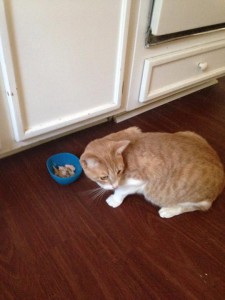
Always feed your pets indoors and keep them inside at night to prevent coyote attacks. Photo credit: Carrie Stevenson
We learned several lessons after our incident that could be helpful to others living in areas populated with coyotes. Like sharks, coyotes are crepuscular creatures—most actively feeding at dusk and dawn. While they prefer to eat small animals like lizards, rodents, and young birds or deer, they are omnivorous and will also eat fruit and grasses. Not unlike other urban wildlife such as raccoons, they are opportunistic feeders and will scavenge dead animals and garbage. One of the best ways to protect small pets is to keep them (and their food) indoors at night and early morning. Pet food left outdoors often attracts coyotes’ normal prey and therefore the coyotes themselves. It is extremely rare to hear of a coyote attacking a human, but if threatened it is recommended that you yell, throw something, or spray a water hose. Stand your ground and fight back—don’t run, as this will encourage them to give chase.
Coyotes are social animals and often hunt in packs, and like the dogs they’re related to, have excellent vision, hearing, and sense of smell. They will howl and bark to communicate with one another, and hearing these vocalizations is often the first sign that there are some living nearby.
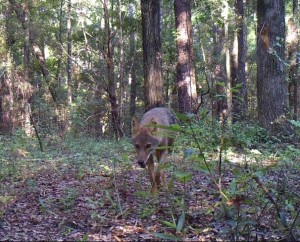
Coyotes are common throughout Florida. Photo credit: W. M. Giuliano
Floridians are no strangers to living with wild animals—we all routinely hear stories of alligators, black bears, venomous snakes, and sharks interrupting our attempts at taming the former wildlands that we now occupy. As urban development marches through the landscape, the large tracts of land once used primarily by animals for hunting and shelter are occupied by human dwellings and transportation routes.
While coyotes are relatively new to Florida (they are native to the western US but entered northwest Florida in the 1970’s), they’ve filled in the ecological gap left by a reduction of native wolves, bobcats, and panthers. Research has shown they now reside in every Florida county and can range the entirety of North America and most of Central America.
Most homeowners will never encounter a coyote, but it is helpful to know they are out there and to take precautions with pets and yard practices to prevent attracting one into your backyard.
For more information on managing coyotes, please visit the UF publication Managing Conflicts with Wildlife: Living with Coyotes.
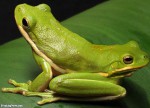
by Sheila Dunning | Jul 7, 2015

There are more than 100 species of plants and animals living in Florida that are in danger of extinction. These trees, flowers, reptiles, amphibians, birds, fish, mammals and invertebrates are listed as either threatened, endangered or species of special concern. As stewards of the land we must question, “What could the loss of a torreya tree, a lupine, a salamander, a butterfly, a woodstork, a right whale, a manatee, a sea turtle or a black bear do to our environment and our quality of life?”
Biological diversity is the variety and variability of species present in an ecosystem including the complex interactions of the many species. Regardless of their size or apparent significance, each species has a role in the circle of life and the food web. Preservation of all species is important. No one knows which ones hold the answers to the future of human existence on this planet.
Many significant developments in medicine have come from obscure plant and animal species. Modern day research includes a vaccine against leprosy being developed because of the nine-banded armadillo and horseshoe crabs being used in developing laboratory tests and finding remedies for several bacterial diseases. In agriculture, genes from wild species may provide the resistance for plant diseases, insects or even weather extremes that could save us from crop failure or possible starvation. There is an interdependence among living things. The extinction of one species may have a domino-like effect on other species. Stability of an ecosystem depends on bio-diversity.
To protect our future and the future of wildlife, the Endangered Species Act became federal law in 1976. This act is intended to protect and promote recovery of plants and animals that are in danger of becoming extinct as a result of human activity. The Environmental Protection Agency is responsible for ensuring the endangered species are protected from pesticides.
Pesticides can kill endangered plants and animals directly or indirectly. Birds mistaking them for food may eat granules, baits or treated seeds. Water contaminated with pesticides ranging in concentrations of less than 0.1 to 1.0 parts per million (ppm) can kill fish. Animals that eat treated crops, drink or wade in contaminated water or feed on tainted prey can be killed indirectly. Some pesticides can build up to lethal levels as predators consume multiple poisoned prey species.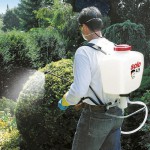
There are certain things you can do to lessen the harmful effects of pesticides on fish and wildlife. Read all pesticide labels carefully to find out whether the use of the product requires special steps to protect endangered species. Determine if the site is designated as the current habitat of an endangered species. Find out this information by visiting http://www.epa.gov/espp/ and http://myfwc.com. When you have a choice of pesticides to use, choose one that is less or non-toxic to fish and wildlife. Read and follow the “Environmental Hazards” section and use the special precautions and measures to minimize harmful effects. Treat only the areas that need to be treated. Leave a buffer zone (untreated area) between bodies of water and treated areas. It is your legal and moral responsibility to protect endangered species by careful use of pesticides in and around their key habitat areas.
Information for this article was derived from University of Florida publications “Pesticide Effects on Nontarget Organisms” by Frederick Fishel and “Applying Pesticides Correctly” by Thomas Dean and Norman Nesheim.
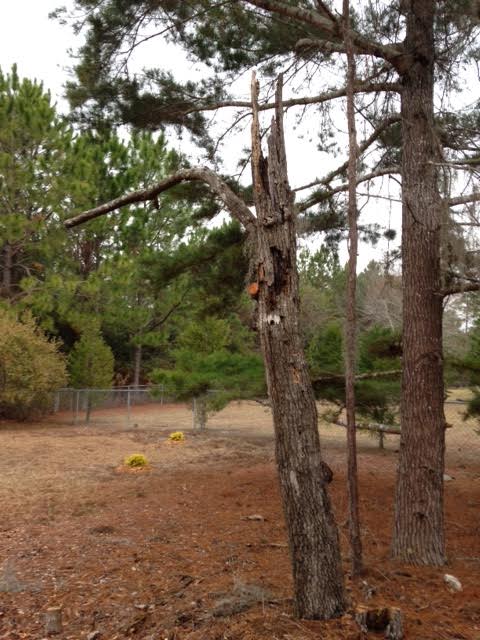
by Julie McConnell | Jan 13, 2015
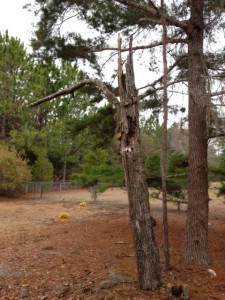
This dead oak tree was trimmed up to make it neater. It is ready for a wildlife resident! Photo: JMcConnell, UF/IFAS
One of the management issues that any landowner will face at some point is what to do when a tree dies in the landscape. The logical response is “cut it down,” but depending on the location and the size of the tree, that may not be necessary and you could be removing potential wildlife habitat.
With any other major decisions about your landscape, always consider safety first. If the tree is in a location where it could damage property or cause harm to people or domesticated animals then it should be properly removed. But what about those trees that are along wood lines or in the far reaches of the yard and not threatening person or property?
Consider leaving the entire tree or modifying it to make it more aesthetically pleasing yet still useful to wildlife. Weak branches or unstable tops may be removed to make the snag less of a risk or to look a little neater.
Some examples of animals that may use dead trees in the landscape are birds, bats, squirrels, frogs, and lizards. Besides the obvious cavity dwelling creatures such as woodpeckers, owls, and bats that are attracted to decaying trees, other animals will be drawn for other reasons. Dead trees in the landscape will become inhabited by insects and fungi which are terrific food sources for birds, mammals, amphibians, and reptiles!
To learn more about providing wildlife habitats in your landscape, please see the EDIS publications listed below or contact your local extension office.
Helping Cavity-nesters in Florida
A Birds-Eye View: How Birds Select Habitat
Dead Wood: Key to Enhancing Wildlife Diversity in Forests
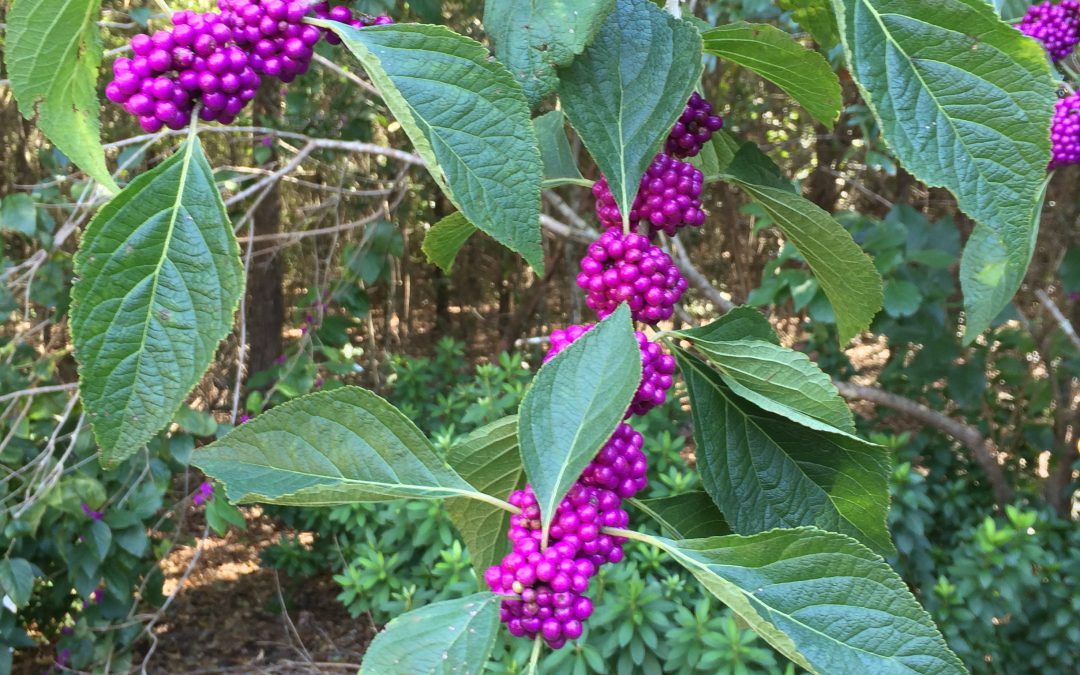
by Mary Salinas | Oct 21, 2014
This autumn you may notice shrubs with long, arching branches sporting clusters of shiny purple berries. That beautiful sight is the Beautyberry, or Callicarpa americana. This native is found throughout Florida and the southern United States, west into Texas and north to Tennessee and Virginia.
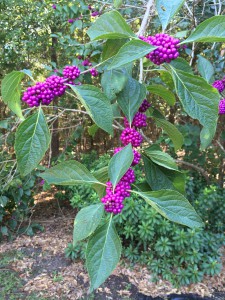
Beautyberry in the fall. Photo credit: Mary Derrick, UF IFAS Extension.
In the spring, lavender flowers adorn the branches and are a favorite of bees. The flowers eventually give way to the shiny purple berries in the fall. Birds find the berries very attractive and will feast on them when found. Mockingbirds and cardinals are especially fond of them. If you plant this shrub for the birds, one or two plants will provide more than enough of the berries to satisfy their appetites.
Beautyberry is adaptable to a wide variety of soils and moisture. After it gets established it is drought tolerant, however it can also do well in a moist area. A spot in your garden that gets partial sun is a perfect location. Plants in too much sun sometimes get a bit yellow and those in too much shade get leggy and don’t set as much fruit. Beautyberry is deciduous, meaning that it will lose all its leaves in the winter. Therefore, you may want to place it in an area of your yard where it won’t be a focal point in the winter.
This lovely plant is usually readily available at independent nurseries. If you prefer to grow your own, beautyberry is easy to propagate and grows rapidly. Snip off an approximate 6-inch piece from the end of a stem; the cut piece should have 5 sets of leaves. Snip off the bottom 2 sets of leaves – this part of the stem will be in the soil and roots will emerge from where the leaves were removed. Also snip off the top of the stem to include the top set of leaves. Your cutting will end up with only 2 sets of leaves. Immediately put the cutting in a good potting soil, making sure that the lower part of the stem where the 2 sets of leaves were removed is below the soil line. Keep the soil moist as the cutting develops a good root system.
You and the birds will enjoy this lovely shrub for years to come!
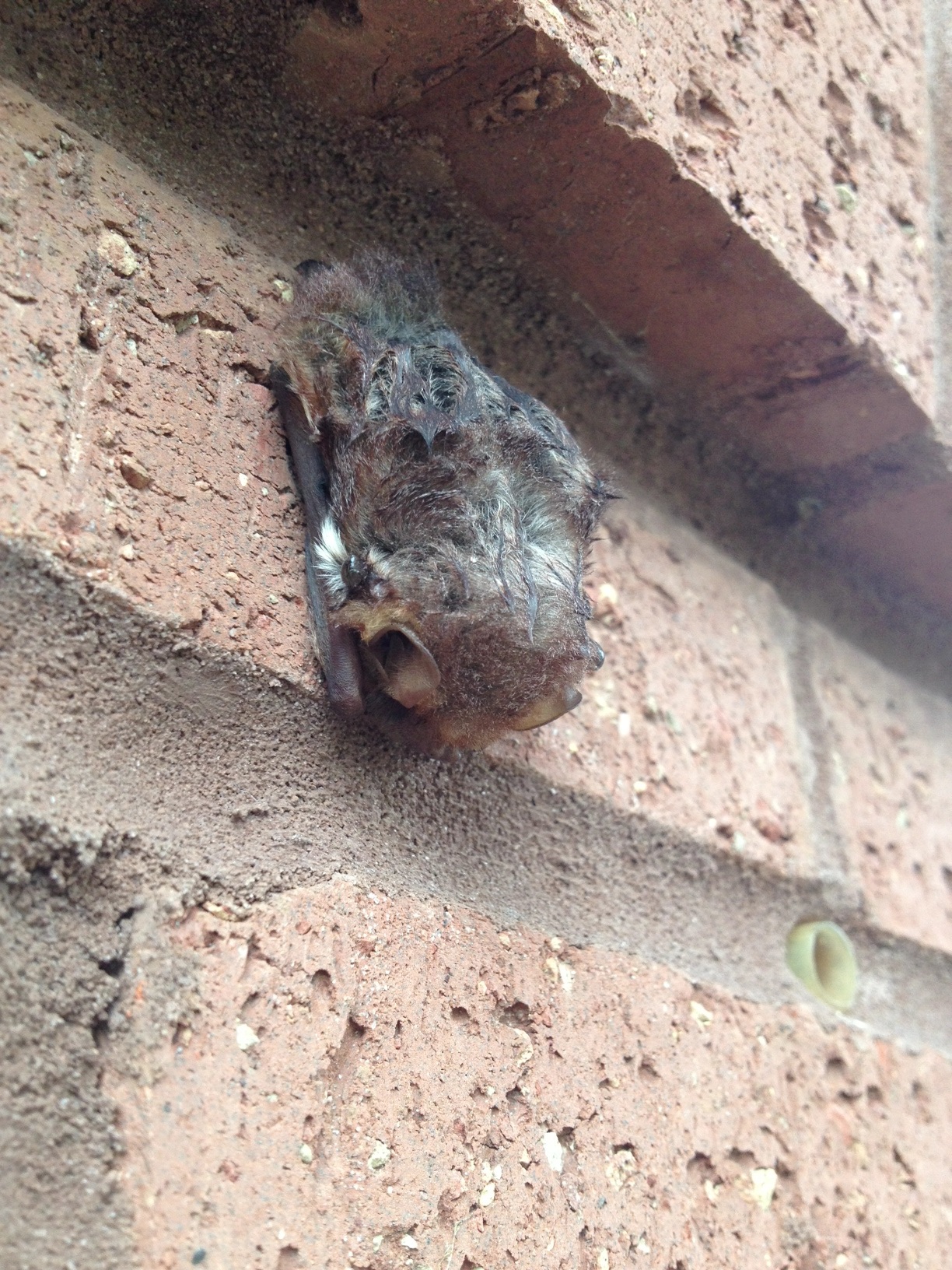
by Carrie Stevenson | Sep 30, 2014
Last week, the Okaloosa County Health Department issued a rabies alert after three bats were determined to have the illness. A “drive-through” rabies vaccine clinic was organized for pets, and warnings were issued throughout the region about making contact with wild animals. One radio broadcast played an interview in which a health department staffer urged people “not to attract wildlife to your yard.” While they were focusing on unsecured trash and pet food, I found this advice unsettling, for as an Extension Agent I’ve promoted the practice of attracting wildlife to yards for many years—birds, butterflies, and even (especially) bats. Raccoons, not bats, have the greatest incidence of rabies (based on data collected from 1992-2011), by a factor of almost seven times that of bats. In the scare of a rabies outbreak, it can be easy to overreact or overlook the many benefits that wildlife provide to our neighborhoods.
There are, of course, practical ways to go about living with wildlife without endangering your health or that of your family and pets (including making sure pets have the rabies vaccine).
Use Caution around Injured Wildlife
Most wildlife rescue organizations do not have the staff to pick up injured animals and ask those who find one to bring them in. However, sick or injured animals may respond aggressively as an intuitive protective measure. If you are taking an animal to a wildlife rehabilitator, be sure to approach it gently and use a blanket or large towel to pick up the animal, and place it gently in a box with a ventilated lid. Great information on responding to injured or deserted animals can be found at the Wildlife Sanctuary of Northwest Florida website. Keep in mind that bats are flying animals and spend almost no time on the ground. They do not chase people and are primarily concerned with catching insect prey. If you find a bat on the ground, it is most likely sick. County animal control or private wildlife responders can also help if you are concerned about interacting with a sick animal.
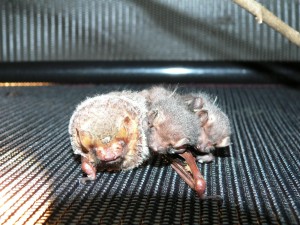
These twin Seminole bat pups were found on the ground with their mother and nursed back to health at the Wildlife Sanctuary of Northwest Florida. Photo credit: Carrie Stevenson
Use Care When Retrieving Dead Animals
When bird flu, West Nile or rabies hits an area, health departments sometimes ask that suspect animals be reported for testing to confirm the cause of death. Even if you are just disposing of the animal, be sure to use gloves and place the animal in a sealable plastic bag to prevent spreading germs, and wash your hands after handling it. If burying, place at least three feet deep and away from wells or water sources.
Enjoy Wildlife from a Distance
Disturbing healthy animals while they are feeding or resting can cause unnecessary stress and reduce their hunting success. Animals’ natural behaviors are fascinating to watch, so be sure and do so from a respectful distance to allow them to interact normally with their environment.












